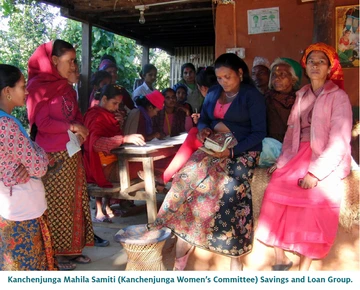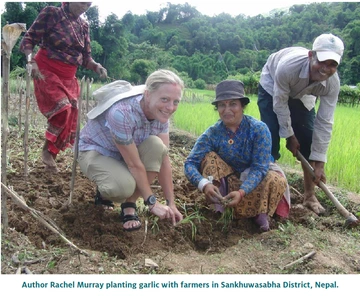by Rachel Murray, WRRC Graduate Assistant

In 2013, a community in the middle hills of Nepal guided me through the fascinating networks of rural South Asian life under modern pressures. The experience confirmed what I had suspected for some time—my personal and professional curiosity with the tangle of culture, society, and nature that constitutes water governance is infinite.
While conducting research on farmer managed irrigation systems (FMIS) and adaptations to climate change in Nepal, I discovered the village of Higuwa tucked into the foothills beneath the fifth highest mountain in the world, Makulu. Higuwa and its proximal villages comprise an agricultural-ecological system (agroecosystem) reliant on small community-built FMIS fed by the nearby Malta River.
Here I made an unexpected discovery about access to water, namely, what appears to be water scarcity may in fact be institutional barriers to accessing water. I saw how simple design elements incorporated into government interventions can result in a cascade of benefits including removal of barriers to water access.
Higuwa and the surrounding communities were experiencing serious water shortages, but upon examination, it became clear that these shortages resulted from potentially rectifiable situations. The narrative that the community and regional government representatives wove for me highlighted potential spots for efficient, effective interventions that increase agroecosystem resilience and scope for adaptations. One particularly desirable target for government action is the nexus of small FMIS and women farmers.
The ward of Higuwa (divided into three “tols”, Higuwa, Sanisare, and Bharajatan) joins eight proximal wards to form a Village Development Committee (VDC). Tols conduct monthly development meetings and each year the municipality provides funding for development proposals that can be in one of four areas: electricity, irrigation, drinking water, or road development. Throughout months of interviews, informal conversations, and focus group meetings, nearly every woman I asked said that Higuwa’s greatest development concern was water, either drinking or irrigation. In contrast, approximately 85% of men answered, road building. The men found road development appealing because it increases the value of the land near the road. Each year that municipal development funding has been awarded to Higuwa’s ward, the money has gone to road construction, leading to obvious questions concerning the lacuna in women’s decision-making power and its potential consequences.
In the mid 1990’s, the District Women’s Development Office (WDO) helped Higuwa’s women form a savings and loan venture, but meetings are held in the morning on the first of each month, the same day and time as the tol development meetings. When I asked why they chose the same time as the development meetings, the President, Sankuntala, replied “We didn’t, our meeting was here first”. The men chose the time for the tol development meetings declaring, “Only the men are enough. The women have their meeting, now we have ours”.
Unfortunately, road building has also created problems for irrigation canal (kulo) functioning. I mapped the central kulo, assisted by Higuwa elders, who pointed out multiple areas clogged with sand from the road above and several sections damaged by yearly landslides that villagers attribute to road construction. The women I spoke with about kulo dysfunction stressed the disproportionate pressure this places on women farmers, because women are in charge of the planting and weeding, which both require water on the field. In addition, two years prior, a road-construction bulldozer destroyed a drinking water pipe that supplied water to two-thirds of Higuwa. As in most of Nepal, women in Higuwa bear the majority of the responsibility for obtaining drinking water, and now they must walk farther to collect water.

In 2010, the government opened a nearby Study Center to expand women’s development programs. Their subsequent actions provide an excellent illustration of the simple design elements in government interventions that can result in cascading benefits. That year, the Malta Study group held a women’s literacy class in Higuwa and one day two people came to this class and told them about an opportunity to start an “income group” wherein the study center would provide seed money and various income generating trainings, if the women could establish small groups of nine, collect matching funds from each woman, and agree to contribute monthly. Within the year women had formed three separate income groups in the Higuwa area, and community members of both genders spoke frequently of the increases in female literacy, confidence, and willingness to speak up.
These small groups are free to decided their own priorities and request specific inputs and are also free to combine with other groups, pooling funds and efforts to increase women’s independent decision-making power across a wide geographic area. For example, the three groups spread across upper and lower Higuwa could collaborate on a shared, multi-purpose water piping or water storage project. This is significant because the women want to pool funds to purchase and install piping from the canal system for the purpose of growing winter vegetables and restoring drinking water.
With regard to intervention design, the government learned that reaching women through literacy training was an effective jumping-off point for spontaneous formation of small women’s savings and loan groups. These groups are able to use small-group learning to create income independence and self-help initiatives, and encourage the creation of more groups. Research indicates that such interventions increase women’s participation in all components of decision-making.
The critical lesson I learned from my teachers and mentors in the community and local and regional government is the imperative that effective interventions be based on clear communication and mutual understanding, an authentic co-production of knowledge.
My current PhD research in the Arid Lands Resource Sciences Program at UA, builds on the foundational understanding of sociohydrological governance from my research in Nepal, expanding to investigations of different scales of power relationships with regard to access to water and land tenure in neighboring Pakistan.

